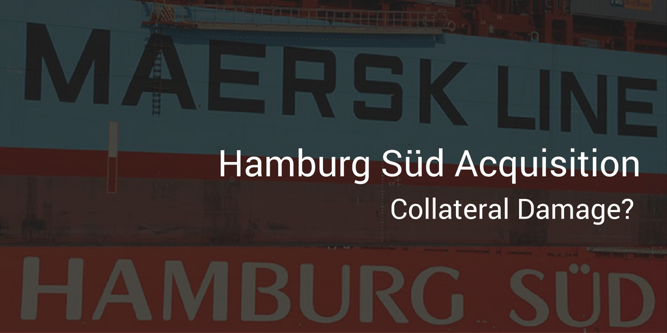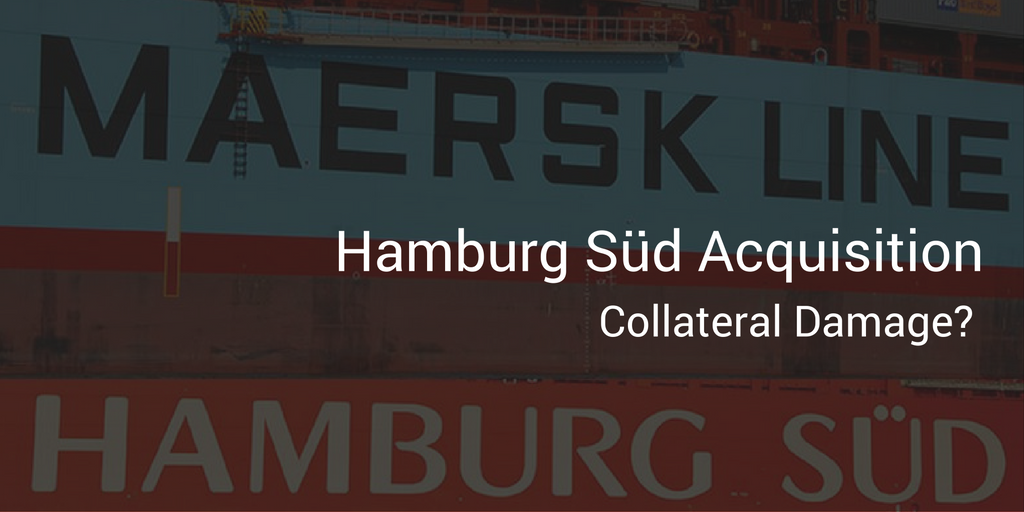
Photocredit: Image from Shipping Herald
In the military world, it's called 'collateral damage,' meaning unintended casualties suffered due to an otherwise planned assault or airstrike. The results are predictable; senior officers apologize, cash payments are made to surviving family members, and an investigation is promised. The Maersk takeover of Hamburg Süd seems to qualify as such an event.
In the aftermath of Hanjin's August's bankruptcy, both shippers and carriers turned to Maersk to see what they would do – buy Hanjin on the cheap? Pick up a few Hanjin ships? Instead, Maersk senior management issued a mild statement that said that while they had no immediate plans to expand, they would look at opportunities if and when something was available that made long-term sense. Their purchase of Hamburg Sud makes long-term sense.
While Maersk is the world's largest box line, their strength is their US and EU routes as well as their cutting-edge and low-cost 19,000+ TEU Triple E's. In conjunction with MSC, the 2M is well-managed, highly-regarded, and very flexible – following the Hanjin shutdown, instead of rushing to purchase their ships and/or routes, they immediately re-configured their schedules in order to take advantage of the shipper's 'flight to safety' in looking for space (even at higher rates) in carrying pre-holiday cargo Korea-EU / Korea-US on a carrier they trusted. These new customers are reported to be sticking with the 2M still today.
Hamburg Süd as Collateral Damage
Formed in 1871 by eleven Hamburg-based trading houses to carry their cargo to-from Latin America, Rudolf A. Oetker KG bought Hamburg Sud in 1955, and expanded it's cargo services to where it's container business ranked in 2015's 7th-ranked box carrier.
Hamburg Sud operates 130 container ships (2015: 48 owned, 82 chartered). The owned ships have a load capacity of between 1,100 and 9,630 TEU, including 21-24% reefer plugs. They are primarily deployed in-out of South America, where they specialize in added-value reefer cargo such fruit, vegetables, fish and meat. The remaining slots were filled with more traditional Latin American cargo such as automotive parts and textiles.
Oetker built a reputation beyond that of a simple carrier by offering competent and reliable service for solutions tailored to customer needs. They offered the entire logistics chain from planning to implementation to door-to-door.
Related Information
Hapag Lloyd: Is There Light At the End of the Tunnel?
What Went Wrong?
Their December 1 press release on the sale to Maersk explained:
“Global container liner shipping has been generating losses for years in the face of rising overcapacity. Nevertheless, Hamburg Süd has performed well compared with its competitors...The owners and management of Hamburg Süd must, however, recognize that active participation in the consolidation process of the sector currently taking place would entail an even higher capital requirement.”
That's what makes Hamburg Sud collateral damage to the Hanjin debacle; that they needed to invest in fleet of megaships in order to remain competitive and (perhaps) profitable. The Oetker family was unwilling to invest, at approx $ 170 million per mega ship, in a fleet of megas that would only serve to acerbate the already 30% overcapacity. With Hanjin's 98-box ship fleet coming onto the used ship market, committing multiple billions of dollars to increase one's fleet is an exercise in ego, and not a prudent business decision.
This is a rare win-win in today's box ship world. Maersk increases it's share of the world box business from 15.7% to 18.6%, while increasing it's value-added reefer and project cargo, while Rudolf A. Oetker KG gracefully exits (subject due diligence) with U.S. $ 5 billion. One hopes all future consolidations end so well.
How M&As Affect Ocean Freight Rates
Disruptions and/or innovation caused by carrier bankruptcies and mergers/acquisitions are changing today’s supply chain at a rapid pace. As such, ocean freight rates can change at a moment’s notice. Faxes, Excel sheets and phone calls usually used during contract negotiations and general market intelligence, is the story of yesteryear.
Learn how the Xeneta platform works and how you can use it to see how your ocean freight prices perform against the market in real time and on demand. Make sure your supply chain flow is not interrupted and stay abreast of current ocean freight prices.
- Data for 60,000+ port-port pairs, trade lane corridors
- 17+ million contracted rates
- Turnkey solution; zero implementation effort






